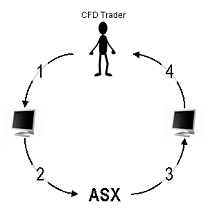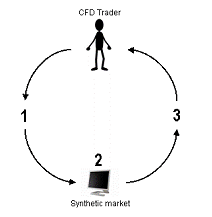CFD’s What are they?
Typically the margin requirement on a CFD position is 5-20%. Simply put a Contract For Difference (CFD) is a product that offers traders the ability to leverage up on a share price rising (going long) or on a share price falling (going short) without having to actually buy the shares in the underlying stock or index. The trader has to hold a cash deposit (known as initial margin) as collateral. Traders purchase CFDs in a share or index and settle the difference (for either a profit or loss) when they sell the CFD.
CFD trading is very similar to normal share dealing:
- You deal at the cash price of the share.
- You pay a commission (brokerage) which is calculated as a percentage of the value of the transaction.
However, when you open a position (trade), you do not have to pay for the full value of the shares. Instead you put up a deposit, typically just 5%, although this can be as high as 20%, depending on the volatility and liquidity of the stock.
CFDs are geared products and can help you realise large gains for small increases in the price of the underlying stock/index, however it is important to appreciate that you are also gearing up your potential losses.
Participate in Corporate Actions – Dividends / Stock Splits
CFDs also benefit from dividends replicate any corporate actions that take place in the underlying share. Typically, your CFD account will receive payments (when going long) and conversely debits (when going short) reflecting dividends paid out.
In other words, the owner of a share based CFD receive cash dividends, and participate in stock splits, just as they would if they owned the physical share. Your account is adjusted to reflect a dividend if you have an open CFD position in the relevant share when dividends are declared. If you are holding a long CFD position then any dividend payment due on the underlying share will be credited to your account. If you hold a short CFD position you will be debited any dividend payments. However, you are not entitled to any voting rights or imputation credits.
CFDs – What types are there?
There are currently only a handful of CFD providers in Australia and it is important to understand the mechanics behind each provider’s model. If you want to trade CFDs, you have two basic choices, the Market Maker Model or the Direct Market Model:
Direct Market Access (DMA) Model – Under this model when you place a CFD order, a corresponding order is placed on the stock exchange. CFD trades under a DMA Model trade on real market prices without added spreads. Investors enter into CFDs at the underlying market price.

|
|
Market Maker Model – Some CFD providers create a synthetic CFD and act as a Market Maker. These prices can potentially differ from the underlying market price as there is a further element of supply and demand dictating the underlying assets, ie the CFDs can trade at a premium or discount to the underlying prices in the market. Since Market Maker Model CFD prices are not controlled by the market, some CFD providers have taken steps to produce a comparable Model by offering a guarantee that their CFDs trade at the market price. Theoretically, CFD providers using the Market Maker Model should offer trades at a lower cost since they do not have to purchase the underlying assets.:
 |
|
